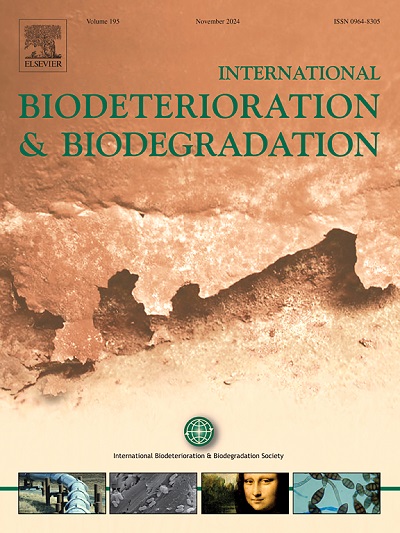Rapid removal of 2,4-DCP by activated carbon loaded nano-zero valence iron immobilized microorganisms
IF 4.1
2区 环境科学与生态学
Q2 BIOTECHNOLOGY & APPLIED MICROBIOLOGY
International Biodeterioration & Biodegradation
Pub Date : 2025-03-21
DOI:10.1016/j.ibiod.2025.106071
引用次数: 0
Abstract
PEG-nZVI/GAC@B was used to repair 2,4-DCP contamination which was difficult to solve by traditional physical, chemical and biological methods. Characterization techniques confirm the successful incorporation of nZVI particles and Bacillus marisflavi into the GAC's surface folds and pores. The polyethylene glycol 4000 (PEG-4000) coating prevents the formation of Fe3+ on nZVI surfaces. Compared to standard GAC, PEG-nZVI/GAC@B demonstrates higher electron transfer efficiency. Key parameters including nZVI content, PEG/nZVI mass ratio, and immobilization time were optimized for maximum efficiency. PEG-nZVI/GAC@B also shows effectiveness in removing other chlorophenol compounds. The removal process primarily involves GAC adsorption, followed by Bacillus marisflavi degradation and nZVI-induced reductive dechlorination. Analyses using IC and GC-MS reveal rapid dechlorination of 2,4-DCP adsorbed on immobilized microorganism by nZVI, with Bacillus marisflavi facilitating further mineralization of the system by degrading 2,4-DCP and its dechlorination products. Most intermediate degradation products exhibit lower ecological toxicity than 2,4-DCP, highlighting immobilized microorganism as a promising solution for 2,4-DCP pollution.
活性炭负载纳米零价铁固定化微生物快速去除2,4- dcp
PEG-nZVI/GAC@B用于修复传统物理、化学和生物方法难以解决的2,4- dcp污染。表征技术证实了nZVI颗粒和marisflavi芽孢杆菌成功地结合到GAC的表面褶皱和孔隙中。聚乙二醇4000 (PEG-4000)涂层可防止在nZVI表面形成Fe3+。与标准GAC相比,PEG-nZVI/GAC@B具有更高的电子转移效率。优化了nZVI含量、PEG/nZVI质量比、固定化时间等关键参数。PEG-nZVI/GAC@B也能有效去除其他氯酚类化合物。去除过程主要是GAC吸附,其次是marisflavi芽孢杆菌降解和nzvi诱导的还原脱氯。通过IC和GC-MS分析发现,nZVI对吸附在固定化微生物上的2,4- dcp具有快速脱氯作用,而marisflavi芽孢杆菌通过降解2,4- dcp及其脱氯产物促进了体系的进一步矿化。大多数中间降解产物的生态毒性低于2,4- dcp,因此固定化微生物是解决2,4- dcp污染的有希望的解决方案。
本文章由计算机程序翻译,如有差异,请以英文原文为准。
求助全文
约1分钟内获得全文
求助全文
来源期刊
CiteScore
9.60
自引率
10.40%
发文量
107
审稿时长
21 days
期刊介绍:
International Biodeterioration and Biodegradation publishes original research papers and reviews on the biological causes of deterioration or degradation.

 求助内容:
求助内容: 应助结果提醒方式:
应助结果提醒方式:


